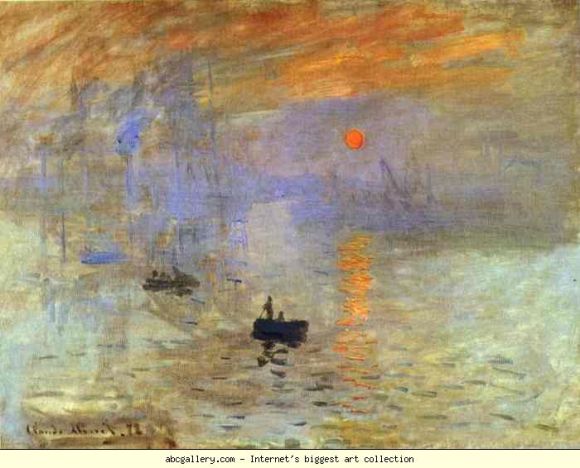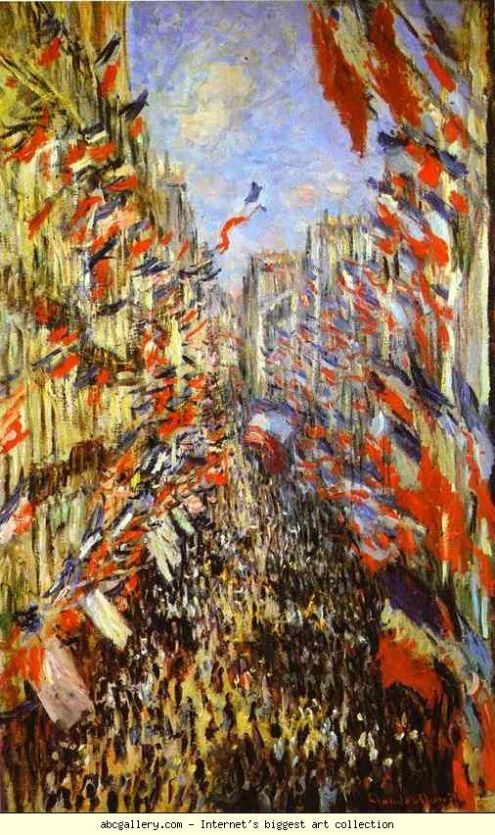I find the impressionists especially fascinating because they are really the first group of painters that were influenced directly by photography. As someone who would consider themselves somewhat familiar with this medium I find extreme interest in seeing how these artists transferred its ideals into paint.
The realistic qualities of photography released painters from the job of capturing life as is. Photography brought freedom to those who once painstakingly attempted to record reality; this could now be done with the open and close of a shutter. Breaking away from this overly refined style was key for the impressionists as they became concerned with capturing the fleeting moment rather than what actually occupied space. John Crowther says it best in the following sentence; “For the Impressionist painters photography could tell them what something looked like, but not how one saw it” (Crowther). They became immensely interested in both sight and capturing the emotion of a scene. Most impressionists painted outside. Due to how rapidly their light source changed they painted quickly and with disconnected brushstrokes. These factors lead to paintings that didn’t necessarily look realistic, but felt as real as renaissance paintings.
 Claude Monet. Impression: Sunrise. 1873. Oil on canvas. Musée Marmottan, Paris, France.
Claude Monet. Impression: Sunrise. 1873. Oil on canvas. Musée Marmottan, Paris, France.
Although these artists were freed by photography we can’t disconnect them from it completely. Impressionists were greatly influenced by the camera and how it was able to capture the world. This influence is evident in many impressionist works. Unusual cropping, blurred subject manner, all over composition and the birds eye view are all directly related to the camera. These things had never occurred to painters before film, but now they couldn’t get enough of it. Photography opened up a whole new set of possibilities for what could be done visually.
 Claude Monet. Rue Montorgueil, Paris, Festival of June 30, 1878. 1878. Oil on canvas. Musée d’Orsay, Paris, France.
Claude Monet. Rue Montorgueil, Paris, Festival of June 30, 1878. 1878. Oil on canvas. Musée d’Orsay, Paris, France.
As a photographer I personally find this style of painting to be of great interest. I look at these paintings, especially streetscapes such as Rue Montorgueil, Paris, Festival of June 30, 1878 (pictured above) and imagine them on film. I think that the impressionists did exactly what it is they had set out to do, capture the essence of the moment. When I look at their works I instantly feel. We connect with their brushstrokes, their intimate use of color. What they did was revolutionary at its time. I’ll quote Crowther once more; “…artists who were angered by the establishment” (Crowther). Most great movement came from resentment of something. Thanks to the camera, this group was able to break free from the Academy. What they did wasn’t well received at first, but they are now one of the most loved groups of painters of all time. I believe that’s because of they way their images emotionally connect with their viewers. We aren’t confused when we glance onto their canvas. We don’t have to think; we just have to feel.
In reaction to this study, I decided to go outside and shoot. My goal was simple; to capture imagery that I believed would interest “todays impressionists”. I designed a shoot that included landscapes, colors and points of view that I felt would have influenced the greats. The following image is my favorites from this endeavor. Following the photograph is a description of why I believe it connects with impressionist ideals.
 This image is how I am personally inspired by impressionism. Though this image was shot from below rather than above, it has many other impressionist qualities. The color palette is soft and pastille, the picture itself was taken outdoors, the tree and water landscape is a common among these artists and the shadow of late day gives the viewer a sense of the fleeting moment or passage of time. I personally love the figure and wanted to in some way include it, although most impressionists weren’t too terribly concerned with this. So to solve this dilemma I kept her off in the distance. She is important to the piece, but not the dominant factor. What is? I believe the lighting becomes dominant in portraying a sense of emotion to the viewer.
This image is how I am personally inspired by impressionism. Though this image was shot from below rather than above, it has many other impressionist qualities. The color palette is soft and pastille, the picture itself was taken outdoors, the tree and water landscape is a common among these artists and the shadow of late day gives the viewer a sense of the fleeting moment or passage of time. I personally love the figure and wanted to in some way include it, although most impressionists weren’t too terribly concerned with this. So to solve this dilemma I kept her off in the distance. She is important to the piece, but not the dominant factor. What is? I believe the lighting becomes dominant in portraying a sense of emotion to the viewer.
Works Cited
“Characteristics of Impressionism.” Florence Griswold Museum : Home of American Impressionism. Visit where the Lyme Art Colony in Old Lyme Connecticut once lived.. N.p., n.d. Web. 3 Dec. 2012. <http://www.flogris.org/learning/foxchase/html/about_impressionism.php>.
“Claude Monet. Impression: Sunrise – Olga’s Gallery.” Olga’s Gallery – Online Art Museum.. N.p., n.d. Web. 3 Dec. 2012. <http://www.abcgallery.com/M/monet/monet36.html>.
“Claude Monet. Rue Montorgueil, Paris, Festival of June 30, 1878 – Olga’s Gallery.” Olga’s Gallery – Online Art Museum.. N.p., n.d. Web. 3 Dec. 2012. <http://www.abcgallery.com/M/monet/monet171.html>.
Crowther, John. “article – Impressionism.” Artist Perspectives – Interviews with Artists. Artist Perspectives, n.d. Web. 3 Dec. 2012. <http://www.artist-perspectives.com/articles/impressionism.htm>.
